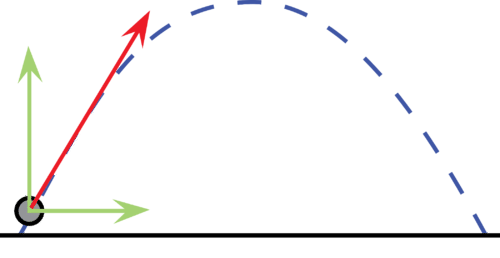READ: Projectile Motion
Projectile Motion for an Object Launched at an Angle
In the case of the human cannonball shown, all the vector and gravitational calculations must be worked out perfectly before the first practice session. With this activity, you cannot afford trial and error – the first miss might be the last trial.
Projectile Motion for an Object Launched at an Angle
When an object is projected from rest at an upward angle, its initial velocity can be resolved into two components. These two components operate independently of each other. The upward velocity undergoes constant downward acceleration which will result in it rising to a highest point and then falling backward to the ground. The horizontal motion is constant velocity motion and undergoes no changes due to gravity.The analysis of the motion involves dealing with the two motions independently.
[Figure2]
Example 1
A cannon ball is fired with an initial velocity of 100. m/s at an angle of 45° above the horizontal. What maximum height will it reach and how far will it fly horizontally?
The first step in the analysis of this motion is to resolve the initial velocity into its vertical and horizontal components.
vi−up=(100. m/s)(sin45∘)=(100. m/s)(0.707)=70.7 m/s
vi−horizontal=(100. m/s)(cos45∘)=(100. m/s)(0.707)=70.7 m/s
We will deal with the vertical motion first. The vertical motion is symmetrical. As the object rises to its highest point and then falls back down, it will travel the same distance in each direction, and take the same amount of time. This is often hard to accept, but the amount of time the object takes to come to a stop at its highest point is the same amount of time it takes to return to where it was launched from. Similarly, the initial velocity upward will be the same magnitude (opposite in direction) as the final velocity when it returns to its original height. There are several ways we could approach the upward motion. We could calculate the time it would take gravity to bring the initial velocity to rest. Or, we could calculate the time it would take gravity to change the initial velocity from +70.7 m/s to -70.0 m/s. Yet another way would be to calculate the time it takes for the object to return to its original height.
If we calculate the time required for the ball to rise up to its highest point and come to rest, the initial velocity is 70.7 m/s and the final velocity is 0 m/s. Since we have called the upward velocity positive, then the acceleration must be negative or -9.80 m/s2
Since this is the time required for the cannon ball to rise up to its highest point and come to rest, then the time required for the entire trip up and down would be double this value, or 14.42 s. The maximum height reached can be calculated by multiplying the time for the upward trip by the average vertical velocity. Since the object's velocity at the top is 0 m/s, the average upward velocity during the trip up is one-half the initial velocity.
The horizontal distance traveled during the flight is calculated by multiplying the total time by the constant horizontal velocity.
Example 2
A golf ball was hit into the air with an initial velocity of 4.47 m/s at an angle of 66° above the horizontal. How high did the ball go and how far did it fly horizontally?

